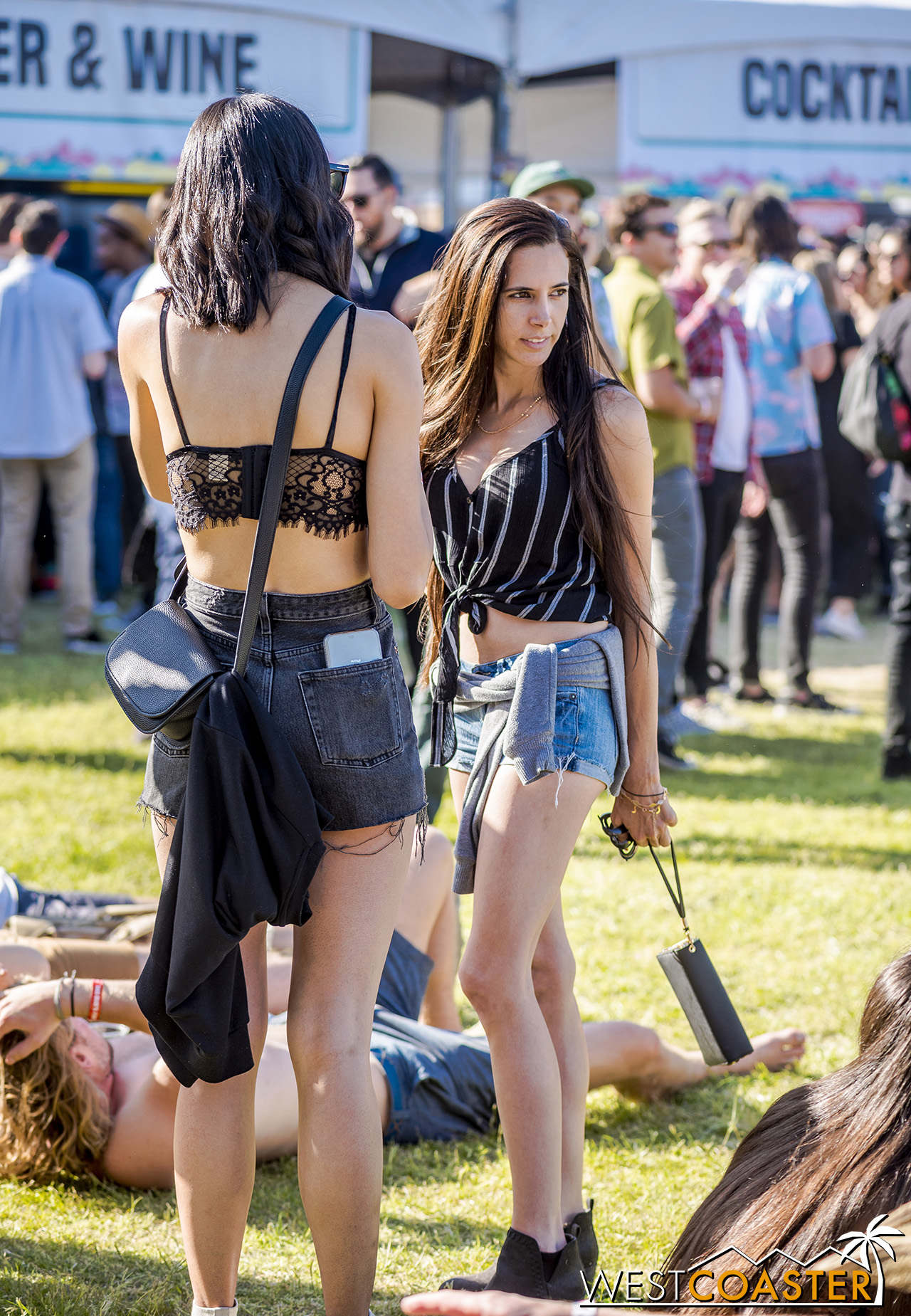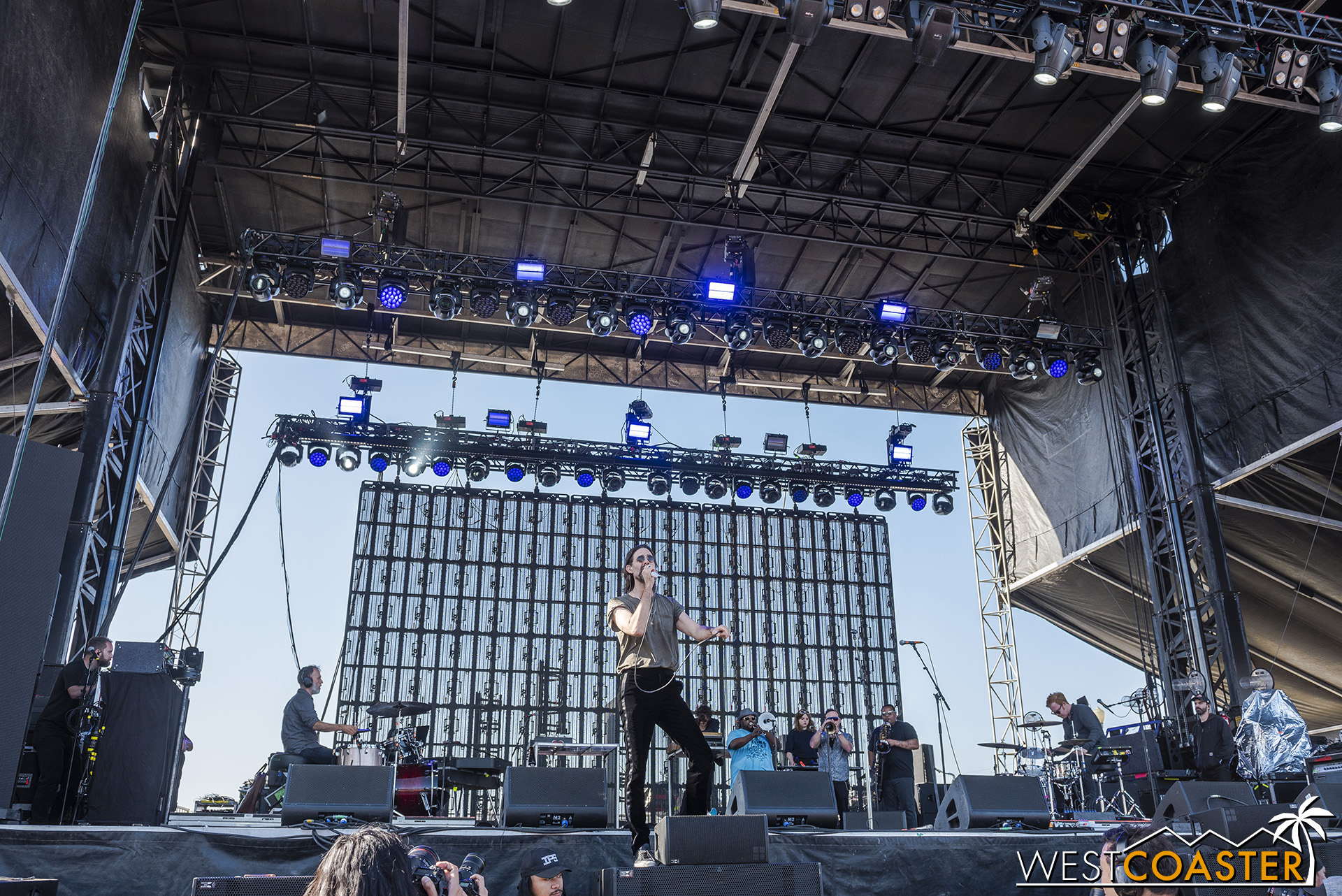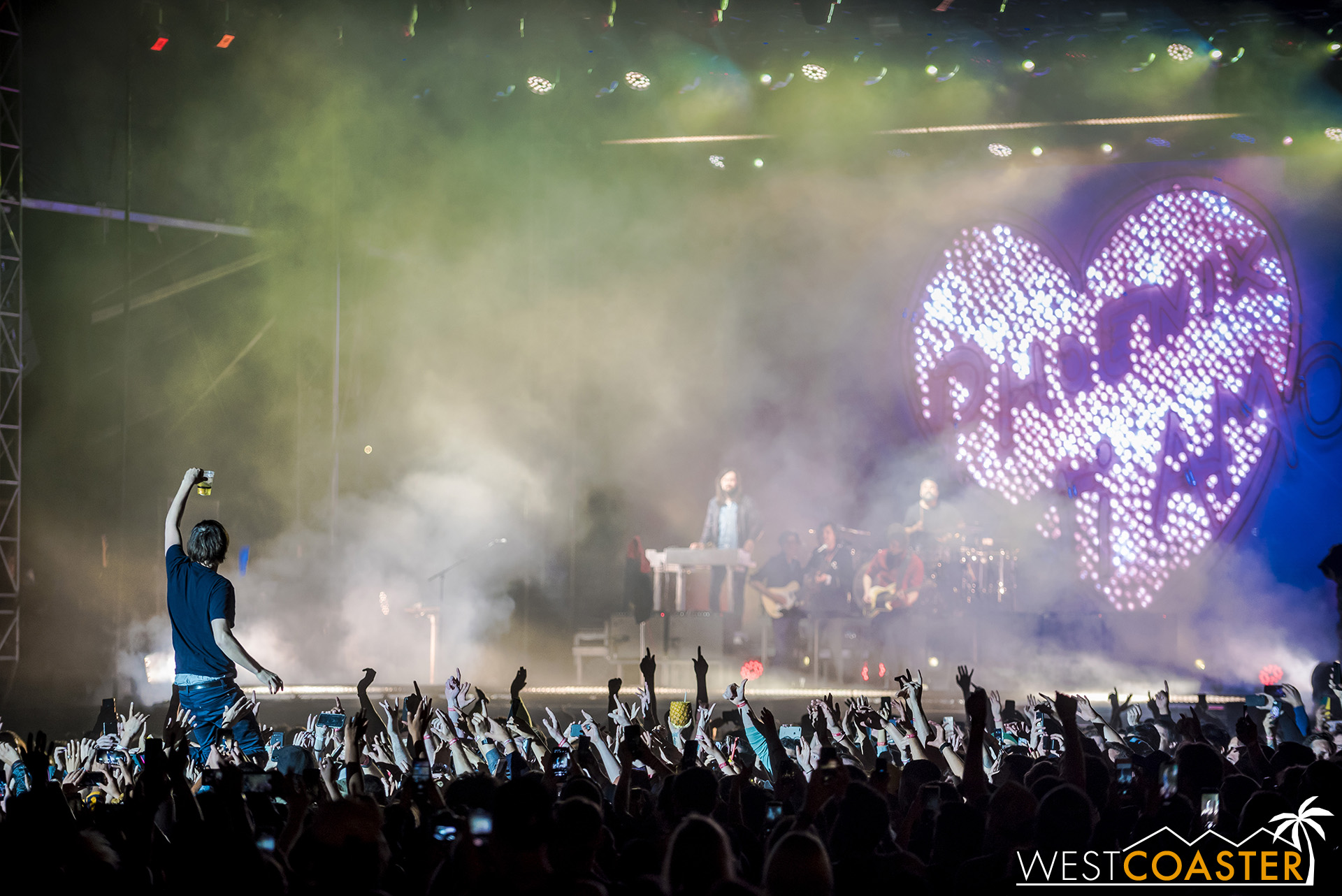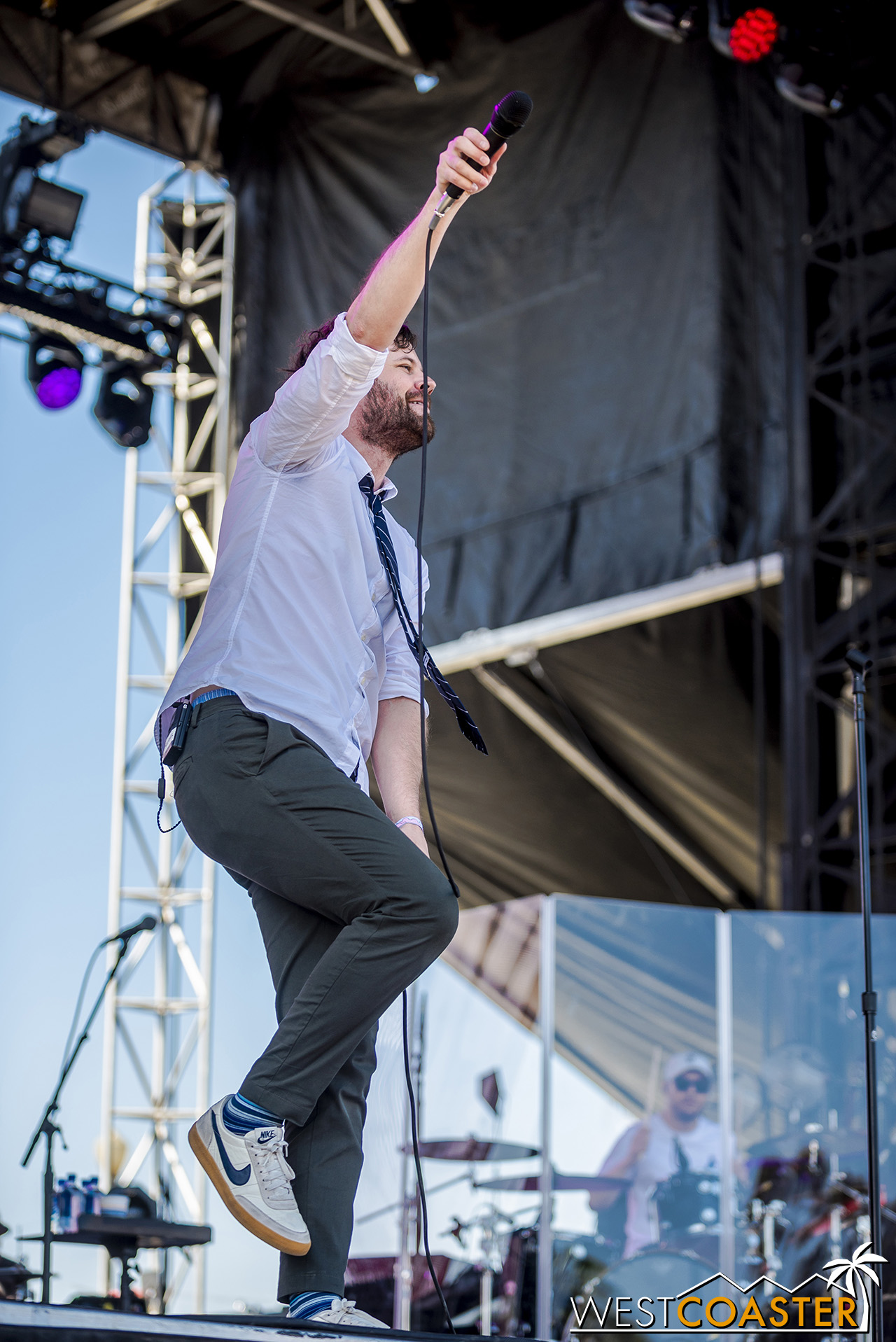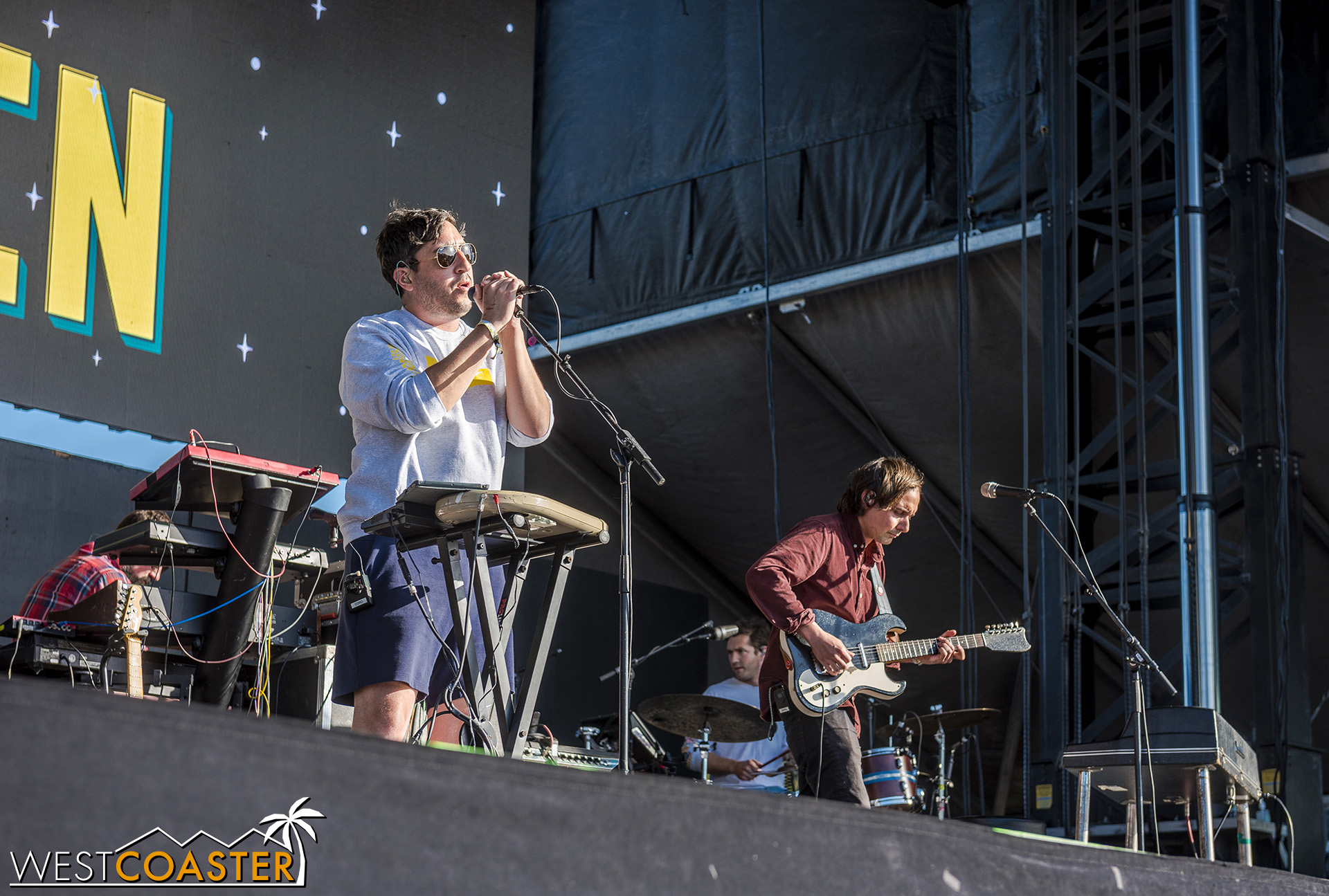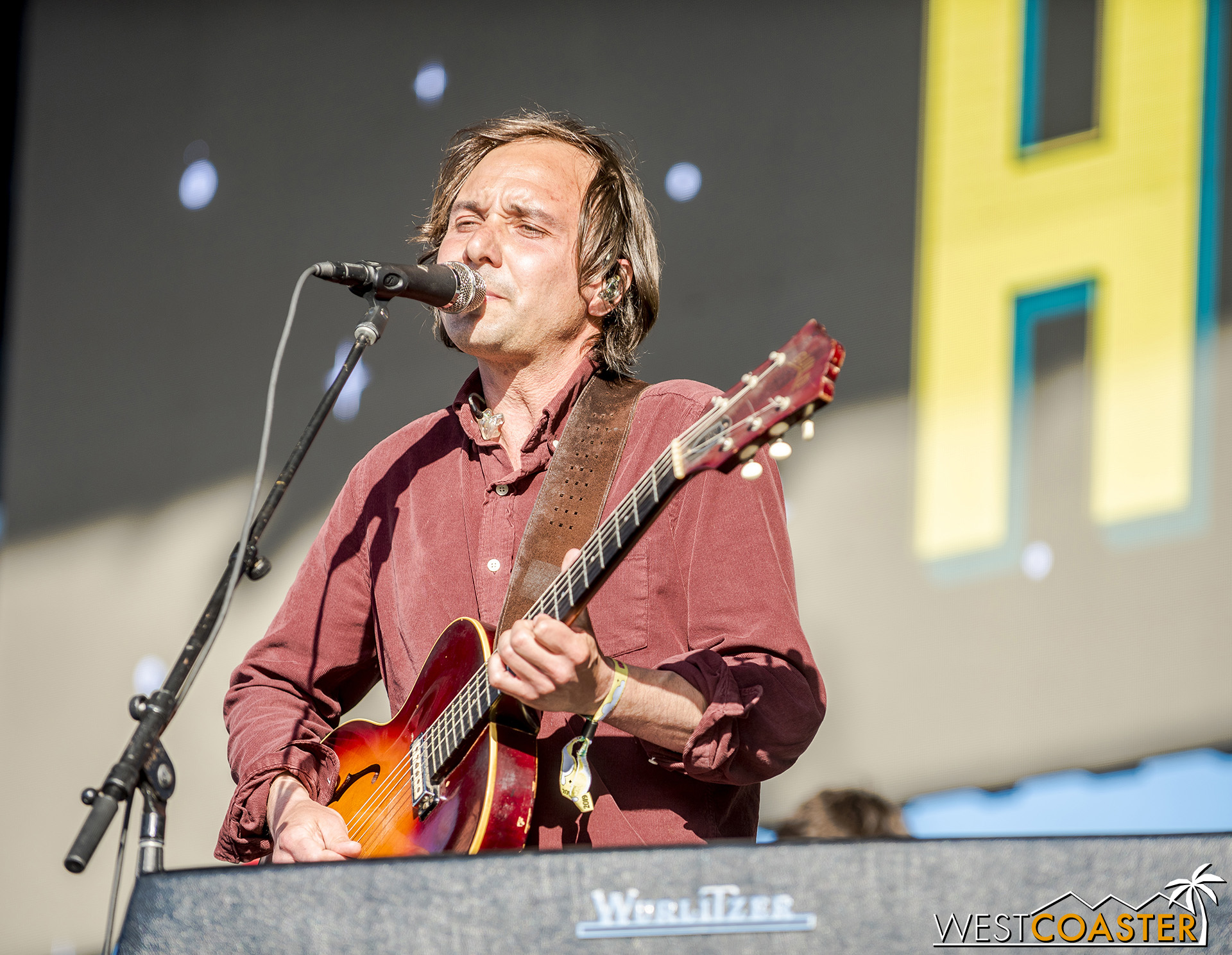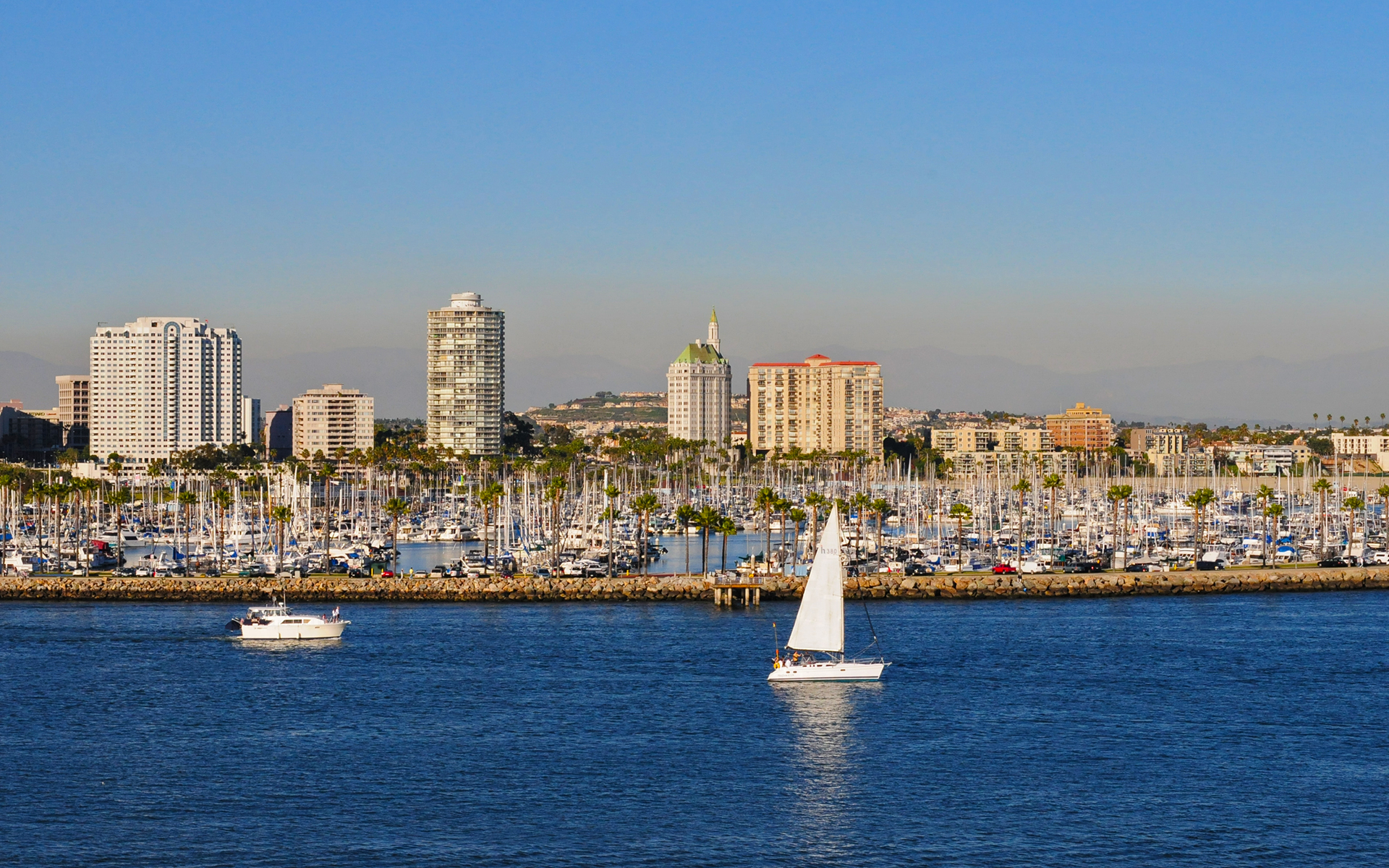Just Like Heaven Festival: 2019 Recap

Queen Mary, Long Beach, CA
Coachella. It’s a name that evokes strong connotations and heavily stereotyped associations. Initially, during the early 2000s, Coachella was more known as a rock festival with smatterings of electronic and R&B. As it built an annual line-up of big names and emerging artists, the event started embracing alternative and indie rock, and eventually even more of a rap and hip hop crowd. Over the past five years, though, Coachella has really evolved into a mainstream gathering intertwined with pop culture, shedding its rough and tumble roots in favor of a more pop, R&B, rap, and EDM audience.
These days, Coachella is as much or even more a festival where one goes to be seen versus one to discover music, and like all things that grow and become successful and change, this has left many past attendees to reminisce about its past, “more authentic” days, and yearn for the lineups that make up their vision of Coachella’s heyday.
The iconic Queen Mary, docked in its Long Beach home of more than fifty years.
Fortunately, the recent rise of beach music festivals has given concert promoters the opportunity to craft large scale events tailored to various musical niches, and for those who enjoy that alternative/indie sector that is associated with the rise of Coachella’s stature, this past weekend’s Just Like Heaven festival presented a divine medley of nostalgic indie acts and sentimental positivity. Over two duplicate days, tens of thousands of music lovers gathered at Harry Bridges Memorial Park, in the shadow of the Queen Mary, to enjoy a “Coachella at the Beach.” Appropriately put on by Coachella promoter, Goldenvoice, and headlined by 2000s / early 2010s favorites like Phoenix, MGMT, and the Yeah Yeah Yeahs, Just Like Heaven Festival lavished its guests with a dream line-up of indie darlings, providing (for many) a retreat back to the “golden days”… before Coachella “sold out.”
A beautiful panorama of downtown Long Beach from the festival grounds.
Located in the Queen Mary’s events park, Just Like Heaven is the latest in a series of targeted music festivals that have proliferated at this site over the past couple of years. Thanks to a multi-year deal signed between Queen Mary leaseholders, Urban Commons, and concert giant, Goldenvoice, the area adjacent to the famed steamliner has seen a series of highly successful music events over the past year-plus. Representing a variety of music genres, festivals like Shipkicker (country), One Love (reggae), and Tropicalia (a bit of everything), and more have been quite effective at pulling in major crowds and ticket sales.
Add Just Like Heaven to the list. After it was announced earlier this year, tickets sold out only several hours after going on sale. Goldenvoice quickly added a second date (on the preceding day, interestingly), which itself also sold a high number of tickets. And this past weekend, the crowds were out across two consecutive days for the terrific line-up of indie poprocktronica.
The venue boasts a capacity of 15,000 people, and as regular guests of Queen Mary’s autumn Dark Harbor event can attest, the local infrastructure around the Queen Mary is very poorly equipped to deal with mass vehicular traffic flow and parking. Knowing this, Goldenvoice wisely made the decision to limit arrival to the festival by shuttle bus only—even to attendees using ridesharing services like Uber or Lyft. Instead, parking was placed in Downtown Long Beach, near Shoreline Village, where a much greater selection of parking lots and structures was available. This placed the burden of the arrival control and management squarely on the shuttle transports.
The results were mixed. Although the festival overall was largely wonderful, the bulk of the criticisms can be placed on the arduous process of parking, boarding a shuttle, and waiting in lines to enter the venue. Despite the organizers’ best efforts, across both days, it took guests on average of 45 minutes to over an hour from arrival at parking by car to arrival at Harry Bridges Memorial Park by shuttle and foot.
The parking itself wasn’t too bad for the most part. It was the shuttle boarding that drew long lines. Early Friday afternoon, it appeared that kinks were still being worked out, as the shuttle line snaked in a loop that crossed itself, with breaks at several locations to yield to vehicular driveway traffic. Unfortunately, these breaks were often not carefully monitored, as on multiple occurrences, guests coming from an opposite direction were able to cut in line while a line control member was looking the opposite way and focused on incoming automobiles. Buses were initially spaced out too far, leaving the queue waiting for the next bus to arrive. Once multiple shuttles ended up stacking at the loading zone, they were initially boarded one at a time, rather than in several groups to speed up efficiency. But fortunately, as the afternoon wore on, the procedures seemed to improve.
The waterfront views do not disappoint!
Guests who did not wish to use the shuttles could opt to walk the two miles from the designated festival parking lots over to the Queen Mary. At certain points in the day, this actually proved to be quicker than waiting for the shuttle—especially if that shuttle briefly became lost on the way, as actually happened on my ride over (fortunately, this was nothing like the runaway bus incident with Dark Harbor last year). By and large, though, operations proceeded much more smoothly once music fans arrived at the actual venue. Though there were long lines for general admission (V.I.P. was definitely worth the cost just to bypass the entry line), the hassles of getting to the site lifted away once guests were finally able to step foot onto the festival grounds.
A permanently docked steam liner in front of a soon-to-depart cruise ship.
Ambiance
The area around the Queen Mary is comprised of a peninsula jutting out from the mouth of the Los Angeles River, and understandably enough, it is relatively limited for land. As a result, instead of a broad, wide-open area, the festival was laid out in two parcels, straddling Queensway Drive, connected by an underground pedestrian tunnel and an overhead bridge spanning over the road. This was effective in minimizing sound bleed between the two ends of the site, but it meant getting around back and forth from the two stages would require some amount of strategy, especially in the wake of minimal gaps between sets.
A map of the festival grounds.
Fortunately, from an infrastructure standpoint, each side of the festival grounds effectively functioned independently, with its own set of food stands, restrooms, merchandise area, water stations, and GA floor and VIP areas. Although Just Like Heaven was billed as a straight music festival, the selection of eats was actually refreshingly diverse, with a welcome choice of food trucks and food stands offering a wide range of international cuisines. From typical festival and carnival fare, like pizza, hot dogs, tacos, and burgers, to more gourmet options like craft mac ‘n’ cheese, vegan menus, Asian fusion, Middle Eastern fusion, BBQ, and more, there was definitely delicious grub for everyone!
Lots of food choices for everyone!
And lots of food trucks too!
Moving back and forth could be problematic at times, though, depending on the route. For many people, it became very clear early on that the tunnel offered the superior avenue to move from the main “Like a Dream” stage to the secondary “Strange as Angels” stage and back. Its ramped descent beneath the street and wider passage made for much faster navigation than the bridge, whose exceedingly steep (and definitely not ADA) stairs backed up entrants on either side and constricted width bunched up pedestrians taking that path.
The bridge over Queensway Drive—one of two methods to traverse the street.
Lines could be long, here with pedestrian backup at the stairs.
Cute decorations inside, though!
The tunnel also offered signs of the whimsical and stylized decorations that Goldenvoice provided just for this festival. Murals and artwork painted on the tunnel walls made for nice backdrops for guests looking for a nice Instagram post, while pops of pastel color and images of halos and angel wings enhanced the casual, serendipitous nature of the festival.
When in doubt, TAKE THE TUNNEL!!
Murals offer fun photo moments for guests.
The “Like a Dream” side offered the more scenic setting for festival goers. With Downtown Long Beach in the background, plus more specialized photo ops and the luxury of using the park’s grassy surface, this side lent itself much better to the grassy Empire Polo Fields ambiance of Coachella than the all-asphalt parking lot making up the “Strage as Angels” side. A hipster-centric general store, an abundance of trees, and the waterfront frontage meant that most people flocked to this side, settling in to enjoy the multitude of great musical acts underneath a spectacular springtime sky—and under much more comfortable temperatures than the Indio desert!
This phone booth provides another Instagrammable moment.
For a first year festival, the aesthetics are remarkably consistent.
One of several little relaxation/photo op areas.
Need a hipster accessory? The General Store has your wares!
But as with any music festival or communal gathering, it was the attendees who gave life and energy to this all-day music party. People-watching at Just Like Heaven very much took on a “Coachella-five-years-ago” aura, but with an even more diverse assortment of people expressing themselves stylistically and fashionably. Granted, flower crowns and pasties were at a minimal, and thankfully, there didn’t seem to be any cultural appropriating garb like Native American headdresses or such. But there were plenty of guests clad in colorful hippie / hipster garb, while others took darker, more beach punk aesthetics. Plenty of people also dressed in coastal-appropriate wear, showing off their beach bods or taking in the sunshine and lovely weather.
Good times and mutual love of music pervade the Just Like Heaven ambiance.
Smiles all around.
The festival attracting a wide variety of guests.
Beyond their wardrobe, it was the enthusiasm and activity of the festival guests that made Just Like Heaven a incredibly fun and enjoyable event. Be it the oceanside vibe or the stereotypical SoCal chill, everything came with a relaxed and easy-going attitude. But people also brought a zest to enjoy the music and experience the songs of some of their favorite bands. There was dancing among strangers, hugs among friends, jumping, moshing, and plenty of rocking out.
In addition, many fans also brought their families to the Just Like Heaven. There was a decent showing of children tagging along with their parents as they enjoyed a wistful day of music, and the inviting nature of the festival allowed them to run around and soak in that infectious energy. Much like Back to the Beach, it was was a delight to see this general love of music be spread from one generation to another. All of this bore proof that music knows no boundaries and has no limits. It unites people of all ages and backgrounds.
These colorful attendees lose themselves and dance to the live music.
No matter what one’s style, the common appreciation for indie and alternative rock and pop brings everyone together.
Looking glamorous in the V.I.P. area.
Always fun to see guests make live music a family affair.
As close to a Coachella group as I could find… love the pizza fan.
By mid/late-afternoon, though, the festival grounds had gotten pretty packed. The layout of the “Like a Dream” side didn’t help. It seemed that a solid 35-40% of the grounds had been devoted to the V.I.P. section, including about half of the stage frontage, leaving the remaining masses to compress in the remaining and much denser space. The location of the elevated ADA disabled user viewing near the shoreline also created a pinch point, greatly constricting pedestrian traffic to the stands on the far house-right side of the park. Although guests seemed to generally keep a concrete sidewalk path clear, nearly all the remaining grass area slowly became a mass of humanity. While crowds are an inevitability at any major music event, the concentration of people bordered on discomfort.
Fortunately, the “Strange as Angels” stage fared better in terms of crowd congestion. This might have been due to the lesser stature of most of the acts performing on that side, or because the VIP area was a more reasonable 20% of the space and tucked in more discretely. In any case, there was certainly more breathing room on this side—though the constraints of the parking lot layout also meant that the GA area was divided into a busier front section separated by parking island curbs and some view-impeding trees as well as a more open back area with more available space but less direct sight lines.
The afternoon crowd starts filling in the venue.
Those in the back sit back and relax.
Save the signage and the backdrop, this could very well be mistaken for a scene from actual Coachella.
Ultimately, despite the issues of the irregular layout of the festival venue and some of the navigation and congestion problems, Just Like Heaven nonetheless proved to be a resounding and gratifying success. There may have been tons of other people around, but everyone seemed more than willing to share space and mutual music love with their fellow festival goers. That achievement tied directly to the fantastic day of music and stellar line-up booked to entertain the fans and thrill the audience.
Music
As the quick sell-out showed, it was the high quality musical line-up that drew thousands to Just Like Heaven. With two stages and 11 hours of live musical programming, the festival definitely lived up to its promises. Starting from noon, indie darlings like Tokyo Police Club, Peter Bjorn and John, and Shiny Toy Guns immediately injected energy into the day. She Wants Revenge also rocked the Dream stage with its dark, post-punk/Gothic rock stylings, while Tennis offered a more melodic and casual tone. Breakbot even entertained the audience on the Angels stage with a half hour DJ set, keeping the dance party going. And all of this was before 3:00!
The Like a Dream GA area was already starting to fill up by the time STRFKR (add your own vowels) went on, at the midpoint of the afternoon. In fitting with the celestial theme, the band came out in astronaut costumes, complete with star-blazing stagehands in matching ensembles. Strumming smooth and chill refrains, STRFKR offered a mellow and relaxing afternoon set, although it wasn’t without its excitement. Near the end of band’s tunes, one of the accompanying astronaut stage performers hopped on a giant, inflatable golden dragon and proceeded to crowd surf it from the front railing all the way to the back of the crowd, eventually touching down a few hundred feet away, well beyond the soundbooth.
STRFKR performs at Just Like Heaven fest.
An astronaut golden dragon surfs the crowd during STRFKR’s set.
The breezy, laid-back tunes continued at the Strange as Angels stage, as Washed Out came on with their blend of chillwave synthpop. Their songs were perfect for this oceanside afternoon, really imbibing the festival with that “Coachella at the beach” atmosphere. With hits like “New Theory,” “Feel It All Around,” and “Armor Fati,” Ernest Greene and his band kept the serene sensations going.
Washed Out performs at Just Like Heaven fest.
Bringing cool sounds and synth melodies.
The energy picked up as Passion Pit took the Dreams stage shortly after 3:30. Michael Angelakos’ trademark high notes and jumpy, spastic spirit quickly had the crowd jumping up and down and cheering. Swiftly working through an array of old favorites from their hit albums, Manners and Gossamer, Passion Pit dazzled the Just Like Heaven crowd with pleasers like “Make Light,” “Little Secrets,” “The Reeling,” “Lifted Up (1985),” and of course, “Take a Walk.” The emotion and, appropriately enough, passion, was on full display, with Angelakos drawing from the animated crowd, who in turn reciprocated his zeal. The first majorly large crowd of the day was into it the entire 40 minutes, and it wouldn’t be the last time that a large majority of the festival attendees gathered to focus on one artist.
Passion Pit, at Just Like Heaven Festival.
Passion Pit frontman, Michael Angelakos.
Back at the Angels stage, Omaha-based The Faint ratcheted up the dance party, delivering their super groovy, swinging, electronic indie rock to a crowd of whirling, twisting revelers. Touching old hits like “The Geeks Were Right,” “Glass Danse,” and “I Disappear,” The Faint issued and funky and exhilarating reminder of the fun workouts entailed in their shows.
The Faint, rocking a dance party at Just Like Heaven.
Lead singer, Todd Fink, sings a song at Just Like Heaven.
The festival tone would ebb and flow throughout the day, and when Miike Snow took the Dream stage late afternoon, the mood once again settled down for a bit of rest. Lead singer, Andrew Wyatt commanded the stage with an effortless, unspoken presence that always felt under complete control. The band included favorites like “Song for No One,” and, of course, “Animal” (a fitting closer). But their recent hit, “Genghis Kahn” was nowhere to be found on the setlist—though this was possibly made up for with a world premiere of their brand new song, “I Was a Sailor.”
American, Andrew Wyatt, of Swedish band, Miike Snow, performs at Just Like Heaven.
Andrew Wyatt, of Miike Snow.
The hypnotic, lounging tunes continued with Grizzly Bear at the Strange as Angels stage. Their set included crowd pleasers like “Losing All Sense,” “Yet Again,” and “Ready, Able.” And of course, there was the Brooklyn trio’s biggest hit, “Two Weeks,” though this surprisingly came in third to last, rather than at the closer. As the afternoon sun started setting, the harmonizing vocals set out a calming and reassuring veil across a rather packed crowd, the biggest yet on this side of the festival.
Grizzly Bear performs at Just Like Heaven.
Grizzly Bear performs at Just Like Heaven.
The tone once again shifted immediately after Grizzly Bear’s conclusion, as San Diego post-punkers Louis XIV brought back rhythm and shredding with a bluesy, garage rock-inspired set that, unfortunately, played out to largely empty crowds. Despite the rather absent audience, who had pretty much exodused en masse to MGMT on the Like a Dream side, Louis XIV maintained a blitzing energy and rock and roll spirit that delighted those who remained. At one point in their set, lead singer, Jason Hill, noted that this was only the band’s fourth show in the past four years. If anything symbolized Just Like Heaven’s motif of bringing indie and alternative cult favorites of a decade ago back to the spotlight—if only for just this weekend, it was this band.
Louis XIV at Just Like Heaven festival.
Louis XIV, performing live for only the fourth time in four years.
If one thought the crowds were hectic prior to MGMT’s early evening performance, the pack of humanity for their set was practically untenable. The endless cascade of people packed in the Like a Dream stage was awe-inspiring. Nearly 20 years in, despite having only two real radio hits, MGMT continues to amass a hugely popular following.
Fortunately, they well earned their adoration during their nearly-hourlong set. With a great electronic sound and a nostalgic setlist (that actually mixed things up a bit across both days, unlike most bands’ identical sets Friday and Saturday), MGMT had the Just Like Heaven attendees passionately ecstatic for each song. The crowd sung together during “Electric Feel,” and the pop of adoration when the playback shouts of “Kids” began was an almost cathartic moment. The band even had some fun when, at the end of their set, they threw out their “encore duck” into the crowd after making them promise to return it. The yellow rubber duck was batted around through the air, “surfing” through the exuberant GA zone.
MGMT and its mass of fans.
The crowd is exhilarated at MGMT.
MGMT tosses their crowd surfing rubber ducky at Just Like Heaven festival.
MGMT’s follow-up would have a tough act to follow, but fortunately, said ensuing artist was The Rapture (“yes, that Rapture,” as Goldenvoice touted in the build-up to the festival), back and reunited after five years disbanded and on hiatus. Luke Jenner, Vito Roccoforte, and Gabriel Andruzzi wasted no time making up for lost performances, turning the Angels stage into an amazing and sustained dance party.
The Rapture’s energy was infectious, and their great enthusiasm and passion showed how clearly thrilled they were to be performing again. Whether guests knew their songs or not was almost immaterial. The Rapture ended up being one of the best acts of the day on account of their sheer magnetism and enticing beats.
I also need to take a moment here to give a shout out to the security staff that handled a potentially precarious situation with quick efficiency and attention. Early on during The Rapture’s set, a clearly hopped up fan (?) aggressively pushed his way to the railing and tried to hop over. Usually, fans who reach the railing are plucked from their crowd surfing and sent on their way, but something in the eyes of this individual suggested unstable and potentially harmful intentions. Fortunately, security hauled him over and quickly subdued him. But even as they were lifting him up, he continued to struggle and fight, clawing his way toward the stage and trying to climb the speakers and platform at the stage apron. Backup quickly arrived to drag him off the grounds and presumably into detention.
Throughout the day, I had noticed how courteous but still focused security had been. But the swift action and quick communication to neutralize this clearly drugged out aggressor deserves commendation, because security’s response certainly maintained guest security and prevented a potentially violent disruption of The Rapure’s performance.
The Rapture performs at Just Like Heaven.
Luke Jenner sings as part of The Rapture at Just Like Heaven.
The Rapture at Just Like Heaven festival.
If MGMT was massive, overwhelming majority crowd part 1, the Yeah Yeah Yeahs duplicated the sprawling concentration a couple of hours later. Here, too, was a band with limited new commercial success over the past decade, with their last album coming six years ago, and yet, the demand to see them performing live was still sky high.
Karen O rocked the set, exuding charisma and excitement and generally appearing to be having the time of her life. From the first notes of “Zero” during Friday’s set, followed by “Y Control,” to the very last riff of Saturday’s closer, “Date with the Night” (fitting given its stature from the band’s debut album) the Yeah Yeah Yeahs epitomized the thrill of the indie rock nostalgia that characterized this entire festival. Sprinkled through the unique sets Friday and Saturday were favorites like “Sacrilege,” “Maps,” and “Heads Will Roll,” among others. But the band mixed up the setlist each day, providing wholly disparate performances.
At one point, prior to commencing their 2003 breakout, “Maps,” Karen O screamed out, “This is the Yeah Yeah Yeahs’ love song!” dedicating the iconic track to her band mates and their families and all the lovebirds out in the crowd and everyone else in audience. Love song indeed, this entire festival proved to be one extravagant love letter to the indie/alternative that orchestrated the soundtrack of an entire generation of millennials.
Giant, bouncy eye-balls hurtle over the crowd at the Yeah Yeah Yeah’s set.
Karen O strikes a pose with the Yeah Yeah Yeahs at Just Like Heaven.
The second-to-last act of the night, Best Coast, closed out the activities of the Strange as Angels stage. Playing under a galaxy of silhouetted noir, Bethany Cosentino and Bobb Bruno serenaded the crowd with their fitting style of indie and surf pop. Super moody, slow, ethereal, and mysterious, their dark and celestial aesthetic provided the perfect way to end one half of a Southern California seaside festival celebrating the aughts of this century.
Best Coast revels in moody darkness at Just Like Heaven.
Bethany Cosentino of Best Coast.
Bobb Bruno plays guitar for Best Coast at Just Like Heaven festival.
Finally, at 10:00pm, it was time for the evening’s marquee headliner to close the festival as a whole. Phoenix, coming near the end of their world tour in support of their latest album, Ti Amo, provided a fantastic mix of songs across their entire catalog. “Ti Amo” and “J-Boy” featured from their latest album, while “Entertainment” and “Trying to Be Cool” and “Drakkar Noir” highlighted hits from their previous. Most of the setlist was heavy in the band’s breakout album, Wolfgang Amadeus Phoenix, including “Rome,” “Girlfriend,” and of course, “Lisztomania” and “1901.” Thomas Mars and company even busted out a pairing from their debut album in the form of “If I Ever Feel Better and “Funky Squaredance.”
To close things out, Phoenix provided a reprise of their disco tribute, “Ti Amo,” as Mars made his way into the crowd. As he has throughout their current tour, Thomas had himself lifted by the fans, crowd standing and crowd surfing through the mass of people as the band played off an instrumental version of the song. He even accepted a beer from a fan and toasted the band, the crowd, and the festival.
It made for an exhilarating end to a terrific festival, ending on a high note and leaving fans to make their way back to the bus shuttles with their heads buzzing from the entire, sentimental day of excellent music. “We’re going to sail back home on the Queen Mary,” Thomas quipped when thanking the fans. The end of Just Like Heaven certainly had attendees cruising with contentment!
Phoenix headlines the night at Just Like Heaven festival.
A rainbow backdrop for Phoenix at Just Like Heaven.
Thomas Mars, lead singer of Phoenix.
Mars in sihouette.
Thomas Hedlund on drums for Phoenix.
Thomas Mars rides the crowd during an encore of sorts at the end of Phoenix’s set.
Mars toasts the crowd during the finale reprise of “Ti Amo.”
Unlike arrival, the exiting process for Just Like Heaven proved to be much more streamlined and organized—though navigating a set of switchbacks at the exit gates did feel a little bit perilous from a mass egress point of view. Still, the loading of buses was much better coordinated, and although there was some amount of waiting involved, it was much less than that of the earlier afternoon. By the time I got to my car, there was zero back-up exiting the parking structure and lot and making my way to the freeway. Given the experience the previous week trying to leave Back to the Beach, I count that as a tremendous win.
Just Like Heaven festival proved to be a monumental success in its inaugural year, bringing in tens of thousands of fans eager to re-experience a bit of their youth (or ten years ago selves) and engage in the live music of some of the biggest names and some of the biggest cult hits in indie rock and pop over the past decade plus. Its well formed identity, cohesive aesthetic, and diverse crowd attraction truly provided a throwback Coachella-esque occasion. It would be a shocker not to see this return next year. Count this as another member of a growing, powerful line-up of festivals that is quickly turning the Queen Mary into one of Southern California’s hottest music venues!
Good night from the Queen Mary events center!
Band Galleries
STRFKR
Washed Out
Passion Pit
The Faint
Miike Snow
Grizzly Bear
Louis XIV
MGMT
The Rapture
Yeah Yeah Yeahs
Best Coast
Phoenix
Architect. Photographer. Disney nerd. Haunt enthusiast. Travel bugged. Concert fiend. Asian.






































